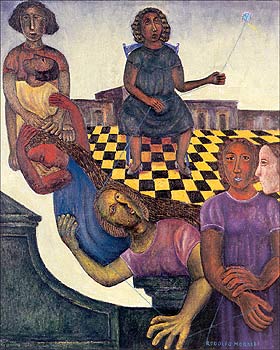La Fundación Cultural Rodolfo Morales,
Jan 01, 1994 - Sep 01, 1997
Oaxaca de Juarez, Oaxaca, Mexico, Mexico
The Art of Rodolfo Morales
by Cynthia MacMullin
This retropective exhibition Rodolfo Morales: Juegos y Evocactiones was first mounted in Oaxaca, Mexico in 1994, for the inauguration of the Fundación Cultural Rodolfo Morales, an institution dedicated to fostering the cultural heritage of Oaxaca, and to stimulating the academic development of the young people of his native village of Ocotlán. The exhibition traveled to the United States and was displayed at the Mexican Museum, San Francisco(Sept 18 - Feb 2,1997) the Instituto Cultural Mexicano,Washington DC, March 1-May 1 ,1997 and The Museum of Latin American Art, Long Beach, June - September, 1997. The art of Rodolfo Morales (b.1924 Ocotlán, died January 30, 2001) is an exuberant celebration of the Mexican village and its people- of their beliefs, religion, fiestas, and music. His art captures the tumult and rhythms of everyday life, and echoes the richness, color and vivacity of the popular culture of Oaxaca. From his student days at San Carlos, Morales pursued a distinctive and idiosyncratic aesthetic, unswayed either by pervasive influence of the Mexican School, or by the successive waves of Internationalism which swept over the land. Morales reflected upon this time. " I spend six years at San Carlos. I had many teachers, but only a few said something to me or showed me something. Most concentrated on having me copy woks of the Mexican School - I, being completely indigenous, had more reasons to paint "Indians" than other artists did; nevertheless, the attitude of the teachers, who had hoped to limit us to the rules and scope of a waning artistic movement, seemed mediocre". The two Mexican artists who Morales credits as having been the most influential to his artistic development were Maria Izquierdo and Manuel Rodriguez Lozano. His painting also is indebted to the European artists Georgio de Chirico, Marc Chagall, Pablo Picasso, and Paul Klee. Morales’ early painting from the 1950s and 1960s, often appears somewhat tentative and experimental, but his characteristic interests, themes, use of colors, and peculiarities of style began to emerge. By the 1970s, he had established his signature style and he began to receive public attention and acclaim. Morales’ art is almost invariably of the village - the archetype is the Ocotlán of his childhood - which is animated by his experiences, dreams, and memories. He vividly recall, "The town was extremely quiet, there was nothing. People were dedicated to their work, to their religion. They would go to Mass and say the rosary. That was about all. But very often, about twice a week, there would be a killing in the town and everything would come to life as everyone came out to see the murdered man...All of this has been etched into my memory." Morales’ universe is defined with quiet churches and unassuming houses, blank doorways and empty arcades; and before them, the villagers dominantly women, engage in festivals, wakes, making music or play. The paintings are almost always quickened by the fabulous: figures float in the sky, disembodied limbs and grotesquely swollen hands and extremities appear; angels, devils, and other apparitions share this phantasmagorical realm. These images are truly theaters of an extraordinary imagination - brilliantly colored, wonderfully fantastic, and always unmistakably evocative of the enchanting land of Oaxaca. Rodolfo Morales completes the triad of the great Oaxacan masters of Mexico who contributed to the developement of 20th Century Mexican art. With Rufino Tamayo (1899-1991) and Francisco Toledo (1940) he has inspired a new generation of young artists and initiated a possible Oaxacan School of Painting.
|













